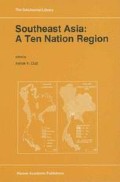Abstract
As one of the most prosperous countries in Southeast Asia, Malaysia has often acted as a leader in developing environmental standards and management strategies for the region.1 Anywhere on the surface of the earth development and modernization will be associated with environmental change. Environmental change inevitably means changing the relationship between human populations and their environment. Ultimately the goal of development must be to achieve a harmonious relationship between populations and their environment. This objective has now become conceptualized by the term “sustainable development”. Sustainable developing “seeks to meet the needs and aspirations of the present without compromising the ability to meet those of the future.”2 The concept brings economy and environment inextricably together such that “…long-term economic growth depends on a healthy environment, so the maintenance of a healthy environment requires continued economic development”.3 Whether or not it is possible to achieve such goals, or even to understand the means of reaching these goals, developing nations such as Malaysia, have had a great deal of success in establishing their own environmental standards as they have developed. This is contrary to a common perception held in the “North”, and particularly in North America, that development in regions such as Southeast Asia is leaping ahead in a manner that will inevitably lead to severe environmental change and destruction of global dimensions. In Malaysia, and other developing nations, however, the situation is often more controlled than in many “developed” nations.
Access this chapter
Tax calculation will be finalised at checkout
Purchases are for personal use only
Preview
Unable to display preview. Download preview PDF.
References
For a comprehensive account of the whole issue of environment and development in Malaysia see S.R. Aiken et al., Environment and Development in Peninsular Malaysia (Singapore; McGraw-Hill, 1982).
Brundtland Commission, Our Common Future (New York and Oxford; 1987), p. 8.
W.R.O. Aitken, The Environment and the Economy (Queen’s University, Kingston, Canada: Centre for Resource Studies Special Paper, 1988), p.4.
R.A. Carpenter, “Using Ecological Knowledge for Development Planning”, Environmental Management, Vol, 4, pp.13–20, 1980.
(From S.R. Aiken et al., op. cit. chapt. 11.)
Based on Tan Sir Suftian, An Introduction to the Constitution of Malaysia (Kuala Lumpur: Government Press, 1972) pp. 133 and 311–317. From S.R. Aiken et al., op. cit. note 1.
Drainage and Irrigation Department, Manual (Kuala Lumpur, Ministry of Agriculture and Fisheries, 1973), p. 74.
S.R. Aiken and G.H. Leigh. A Second National Park for Peninsula Malaysia? The Endau-Rompin Controversy. Biological Conservation, Vol. 29, (1984), pp. 253–276.
S.R. Aiken, Struggling to Save Malaysia’s Endau-Rompin Rainforest, 1972–1992. Environmental Conservation,Vol. 20, (1993), pp. 157–168.
New Straits Times, K. Lumpur, 5 August 1978.
T.S. Teh and T.S. Bahrin, Environmental Impacts of Land development in Jengka Triangle, Pahang, Peninsular Malaysia in P.K. Voon and T.S. Bahrin (eds.) The View from Within: Geographical Essays on Malaysia and Southeast Asia, (Kuala Lumpur: Malaysia Journal of Tropical Geography Special Publication, University of Malaysia, 1992), pp.84–117.
For a review of the Jengka Triangle scheme see T.S. Teh and T.S. Baldwin ibid
T.S. Bahrin and P.D.A. Perera, FELD A: 21 Years of Land Development (Kuala Lumpur, FELDA, 1977).
T.S. Teh and T.S. Bahrin op. cit p.98.
S.R. Aiken and M.R. Moss, “Man’s Impact on the Natural Environment of Peninsular Malaysia: some Problems and Human Consequences.” Environmental Conservation Vol. 3, (1976), pp. 273–283.
S.R. Aiken and M.R. Moss, ibid; S.R. Aiken and M.R. Moss, “Man’s Impact on the Natural Environment of Peninsular Malaysia: some Problems and Human Consequences.” Environmental Conservation Vol. 3, (1976), pp. 273–283
S.R. Aiken and M.R. Moss Tropical Rainforest of Peninsula Malaysia: A Review”. Biological Conservation Vol. 8, (1974), pp. 213–219;
S.R. Aiken and C.H. Leigh, Vanishing Rain Forest: The Ecological Transition in Malaysia (Oxford: Clarendon Press, 1992).
J.L. Harrison, The Effect of Forest Clearance on small Mammals in L.M. Talbot and M.H. Talbot (eds.) Conservation in Tropical South-East Asia (Morges, Switzerland, IUCN, 1968), pp. 153–158.
AUSTEC, Pahang River Basin Study, Volume 3, Basin Hydrology and River Behaviour (Cooma, N.S.W., 1974).
I. Douglas, The Environment Game (Armidale, N.S.W., University of New England, 1972)
I. Douglas, The Impact of Urbanization on River Systems, in Proceedings of the IGU and 8th N.Z. Geographical Society Conference (Auckland, N.Z. Geog. Soc., 1974), pp. 307–317.
S.R. Aiken et al. op. cit. note 15, chapt. 9.
S.R. Aiken and C.H. Leigh, “Malaysia’s Emerging Conurvation.” Annals, Assoc. Amer. Geographers, Vol. 65, (1975), pp. 546–563.
L. Klein, Aspects of Water Pollution (London: Butterworths, 1957).
S.R. Aiken and G.H. Leigh. op. cit. note 19
S.R. Aiken et al., op. cit. note 1, chapt. 9
S.R. Aiken and C.H. Leigh. “Squatters and Squatter Settlements in Kuala Lumpur” Geographical Review, Vol. 71, (1981), pp. 158–175.
D. Owens, “Coliform and Escherichie coli Bacteria in Seawater and Penang Island, Malaysia” Water Research, Vol. 12, (1978), pp.365–370.
Environmental Protection Society of Selangor, A Study of the Extent of Pollution of the Sungei Kelang and its Main Tributaries (Petaling Jaya, 1975).
New Straits Times (Kuala Lumpur) 14 May 1978.
Malaysia, Sixth Malaysia Plan 1991–1995 (Kuala Lumpur).
Author information
Authors and Affiliations
Editor information
Editors and Affiliations
Rights and permissions
Copyright information
© 1996 Kluwer Academic Publishers
About this chapter
Cite this chapter
Moss, M. (1996). Malaysia: Managing the Environment in a Rapidly Developing Society. In: Dutt, A.K. (eds) Southeast Asia: A Ten Nation Region. The GeoJournal Library, vol 34. Springer, Dordrecht. https://doi.org/10.1007/978-94-009-1748-4_15
Download citation
DOI: https://doi.org/10.1007/978-94-009-1748-4_15
Publisher Name: Springer, Dordrecht
Print ISBN: 978-94-010-7281-6
Online ISBN: 978-94-009-1748-4
eBook Packages: Springer Book Archive

